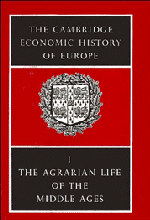Book contents
- Frontmatter
- Chapter I The Settlement and Colonization of Europe
- Chapter II Agriculture and Rural Life in the Later Roman Empire
- Chapter III The Evolution of Agricultural Technique
- Chapter IV Agrarian Institutions of the Germanic Kingdoms from the fifth to the ninth century
- Chapter V Agrarian conditions in the Byzantine Empire in the Middle Ages
- Chapter VI The Rise of Dependent Cultivation and Seignorial Institutions
- Chapter VII Medieval Agrarian Society in its Prime
- Chapter VIII Crisis: From the Middle Ages to Modern Times
- BIBLIOGRAPHIES
- Plate Section
- The Roman frontier and the Teutonic Tribes in the first and fourth centuries A.D.
- The Empire of Charles the Great
- Germany in the thirteenth century
- References
Chapter III - The Evolution of Agricultural Technique
Published online by Cambridge University Press: 28 March 2008
- Frontmatter
- Chapter I The Settlement and Colonization of Europe
- Chapter II Agriculture and Rural Life in the Later Roman Empire
- Chapter III The Evolution of Agricultural Technique
- Chapter IV Agrarian Institutions of the Germanic Kingdoms from the fifth to the ninth century
- Chapter V Agrarian conditions in the Byzantine Empire in the Middle Ages
- Chapter VI The Rise of Dependent Cultivation and Seignorial Institutions
- Chapter VII Medieval Agrarian Society in its Prime
- Chapter VIII Crisis: From the Middle Ages to Modern Times
- BIBLIOGRAPHIES
- Plate Section
- The Roman frontier and the Teutonic Tribes in the first and fourth centuries A.D.
- The Empire of Charles the Great
- Germany in the thirteenth century
- References
Summary
Between the great agricultural enterprises of antiquity based on slavery, which survived in a modified form as the great manorial estates of the Carolingian era, and the great capitalist estates of modern times, lie the small farming units characteristic of the feudal period. After the charges due to the lord had been paid, these small tenant farmers aimed first and foremost at providing subsistence for their families. But at the same time their energy and the productivity of their holdings were sufficient to sustain the great movement of reclamation which reached its peak in the twelfth century. The evolution of agricultural technique in the Middle Ages which made these changes possible can be divided into three main phases:
(1) From the fifth to the tenth centuries the introduction of a series of technical innovations, some large and some small, and the diffusion of others inherited from Roman antiquity, but not hitherto widely adopted, increased productivity on the small units to an extent which gave them an economic advantage over the larger estates worked by forced labour. Among such innovations were the wheeled plough, modern harness, the flail, the water-mill, improved ways of harrowing fields, made possible by the use of the horse as a draught animal, the extension of more easily grown crops such as rye and oats, the first attempts at a three-year rotation. Such simple tools as the hoe and the flail brought great advantages to those who used them; and acquired an immense economic significance because they came to be used in enormous numbers and because they could be used for long periods during the working year. Polish ethnographers have calculated that in their country the use of improved flails increased productivity by about ioo per cent.
Keywords
- Type
- Chapter
- Information
- Publisher: Cambridge University PressPrint publication year: 1966
References
- 7
- Cited by

